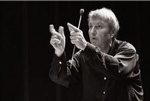Trust cannot be declared. It is built. In the meantime, one observes the other with caution. One takes initiatives, takes a step, then diplomatically, reconsiders, thus leaving the other the necessary space to dare in turn. This was somewhat the spectacle presented on Tuesday, September 15, 2009, by the Nice Philharmonic Orchestra and its new conductor from Cannes, Philippe Bender.
Despite a highly eclectic program, open to multiple influences, the evening was monolithic, marked by restraint, stuck in a surprising classicism for works that nonetheless demanded boldness and character. Aside from the “Overture to Candide,” a musical comedy composed in 1956 by Leonard Bernstein played with fervor as the introduction, the three other pieces of this “special concert” were enough to weary the many listeners in the Apollon room of the Acropolis: the very famous “Rhapsody in Blue,” a concert rhapsody for piano and orchestra by George Gershwin, was interpreted devoid of any “jazzy” imprint, rotund despite its angular rhythm, sinking body and soul into a tearful lyricism, even bordering on the boring. While pianist Krystian Zimerman brilliantly saved appearances by engaging in a fierce – and somewhat solitary – duel with his challenging score, maestro Philippe Bender, who had previously rehearsed this program with his ensemble of young Cannes musicians, seemed rather to abandon the Orchestra to its fate, occasionally resuming his role as director here or there. Was he seeking to give more interpretative space to the Philharmonic, as its musicians had frequently criticized his predecessor Marco Guidarini for his very “controlled” direction? Was he merely testing them? In any event, the Nice formation, which had supplemented its ranks for the occasion with an excellent flutist from the Cannes Regional Orchestra, managed this unexpected “void” of authority rather well.
Unfortunately, the same scenario occurred in “El sombrero de tres picos” (second suite) by Manuel De Falla and “Daphnis et Chloé” (second suite) by Maurice Ravel. Born from two ballets created by the famous Ballets Russes on a commission from Sergei Diaghilev, these two works possess a powerful mark inspired by their authors. Yet it must be observed that the rich Iberian color of the first seemed “bleached” by a minimalist and bland direction, while the latter was forced into a debatable purely romantic interpretation, chaining broad melodic phrases that altered the delicate precision of Ravel’s writing.
In extremis, an “encore” dedicated to the American victims of September 11th brought an authentic emotion to the hall that one might have wished to detect a bit earlier.


